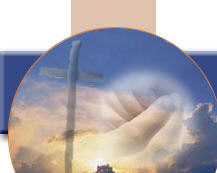



|
|
Overview |
|

![]()
The Journey completed:
Dying, Death and Funeral Rites.
"In my end is my beginning."
T.S. Eliot
The one thing we all have in common about the journey of our lives is
death. Happy thought! It is really if we put death in the context of Eliot's
words and of Meister Eckhart's statement ‘One must be dead to see God.’
Jesus' life was a journey. He set his sights on Jerusalem where he was to
give his life in death. In his journey there is a great revelation. His
perspective on death sought to turn death's destructiveness to hope. He
lives beyond death. He rose from the dead.
The Christian tradition seeks to speak of this hope by surrounding death
with many elements of sacramental life. The Rites of dying remind a person
of the promise of their BAPTISM. The promise of everlasting life was given
in their rebirth in Christ.
We are reminded of the way that Jesus himself turned his desolate cry ‘My
God, My God, why have you abandoned me!’ into ‘Father, into your hands I
commend my Spirit’ and so came to know that eternal spirit of life that they
celebrated in CONFIRMATION.
We are given the Bread of Eternal Life, the ‘living bread come down from
heaven’, ‘anyone who eats this bread will LIVE FOREVER’. We are on a final
journey and, as with the people in the desert in Moses' time, we are given
the Bread from heaven, the Manna, to help us on our journey through the
desert of death to the Promised Land. This is bread for the way - VIATICUM
(Literally ‘on the way with you’). This is the Sacrament of the dying.
The dying person celebrates the ANOINTING OF THE SICK. In earlier times
Anointing of the Sick was called ‘Extreme Unction’ and came to be seen as
the sacrament of dying and, often, of death. We are recovering the idea of
the ‘bread for the Journey’ as the last sacrament. The oil, blessed the
previous Easter, brings hope in the final healing of death. The laying on of
hands speaks of solidarity with the dying person and the power of the Spirit
that raises the dead to eternal life. Again we are faced with the thinking
about this sacrament as the last sacrament, ‘Extreme Unction’. This is
giving way to its new significance. There is still a residue of this
thinking around, however, so that people are reluctant to ‘call the priest’
to celebrate this sacrament as it is seen as a symbol of imminent death.
As we have said in unit 9, in the experience of illness a person has an
experience of sin. The dying celebrate RECONCILIATION to be at peace within
themselves so that they realise their dying has nothing to do with their
personal sin but it is, rather, a mystery to be entered into with hope. In
dying , a person is linked with the suffering of Jesus, the innocent one,
who suffered and died for the life of the world.
MARRIAGE and friendships are obviously associated with dying. For the dying
person to ‘let go’ of their spouse, family and friends calls for a vision of
love that sees eternal love as that which is the promise and fulfillment of
the relationships of this present physical realm of life. For the family and
friends to let go physically, to give ‘permission’ to die, and to begin to
enter into a new spiritual relationship with the dying person, calls for an
heroic spirit, a deep hope and a love that transcends death. The words of
the Song of Songs come to mind in this context :
Set me as a seal upon your heart
as a seal upon your arm;
for love is strong as death,
Its flashes are flashes of fire....
passion fierce as the grave.
Love can no flood quench,
no torrents drown. (Song of Songs 8:6-7)
The family and friends of the dying person are drawn into all these meanings
as they begin their grieving in the days, weeks and months of the final
illness.
The violence of sudden death, like a car accident, is that people have not
had a chance to experience this process. They have no time and are shocked
into a situation that needs great, sudden, adjustment. They are helped by
the Funeral rites that speak of them accompanying their deceased on the
final journey. The Funeral Rites themselves are a journey, a process that
expresses the stages of grief.
The 1989 Order of Christian Funerals speaks especially to the family of the
deceased. Dying and Death and the Rites of Christian Burial are surrounded
by symbols that express and sum up the sacramental life.
During the FUNERAL RITES the grieving,
- are led to hope in the promise of BAPTISM as we sprinkle the body and the
coffin with Water and accompany the body on its last journey;
- recall the life of the eternal Spirit celebrated in CONFIRMATION as they
remember the words of the Father ‘you are mine, the beloved, my favour rests
on you’;
- are united with the deceased by being one in the ONE BODY OF EUCHARISTIC
LIFE, the BREAD OF ETERNAL LIFE;
- speak of their relationship to the deceased as family members or friends
give eulogies at the rites and all are invited into NEW RELATIONSHIP OF LOVE
in the SPIRIT - a relationship expressed in our time of human love (and
MARRIAGE) with the deceased;
- live as MINISTERS of the Good News as they minister consolation and hope
to one another until, in their turn, join this great band of the Servants of
God. The ORDAINED focus this journey for them;
- are healed of despair and loss by the Spirit of Jesus and his Word of Life
that ANOINTS US.
The funeral rites have three main moments - VIGIL, THE FUNERAL MASS/LITURGY,
THE COMMITTAL. These three moments have an integrity and ‘passage’ that
speak to our understanding of the grief process and our need to journey with
one another and with the deceased in these last moments. One consequence of
the pressures modern life is that we can telescope these three rites into
one. The three rites seek to help people face and confront the grief as a
process. The one rite can let people resist and escape this process.
The three rites in progression give us a theology and psychology to prepare
for and to celebrate the death of a person.
- The VIGIL and RELATED RITES AND PRAYERS give us the opportunity to speak
with personal and intimate expressions of grief. In our multicultural
societies cultural elements are especially relevant in these ceremonies. The
story of the person's life is told.
- The FUNERAL MASS or LITURGY asks us to bring that personal, intimate grief
to the story of Jesus, especially his dying and rising to new life,
expressed in Word and Sacrament. The story and life of the deceased is taken
up into this great Story, the Good News.
- the COMMITTAL speaks of an end of the old relationship and the creation of
a new relationship based upon prayerful remembrance, gratitude and hope of
resurrection and reunion.
So the Journey ends yet as T. S. Eliot says "in my end is my beginning".
What we have known through God-given symbols in our prayer and Sacramental
life, we know ‘face to face’ in eternity. We come to completeness in our
relationships in the eternal Love that is God. We are drawn into a completed
creation that includes our bodily resurrection.
Our journey is complete.
|
|
|


Copyright © Anthony Kain 2009